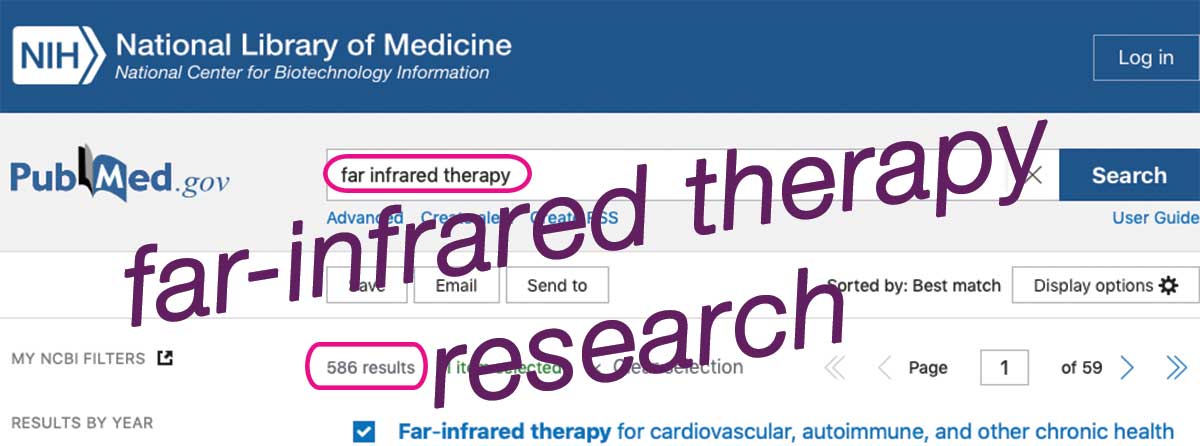NIH PUBMED MEDICAL RESEARCH on FAR INFRARED THERAPY – Search LINK
There is a lot of published medical research as to the effects of Far Infrared Thermal Therapy. This Link will survey current published links
MEDICAL RESEARCH on FAR INFRARED THERAPY – article by Dr Aaron M. Flickstein LINK
- The Use of Infrared Heat to Produce Cardiovascular Conditioning
- History of the Sauna and Development of Infrared Technology
- World-Wide Reports on Infrared Sauna Use
- Musculoskeletal Improvements with Infrared Heat
- Effects of Infrared Heat on Rheumatoid Arthritis
- Other Therapeutic Effects of Infrared Heat
- Infrared heat increases the extensibility of collagen tissues.
- Infrared heat decreases joint stiffness
- Infrared heat relieves muscle spasms.
- Infrared heat treatment leads to pain relief.
- Infrared heat increases blood flow.
- Infrared heat assists in resolution of inflammatory infiltrates, edema, and exudates.
- Infrared heat introduced in cancer therapy.
- Infrared heat affects soft tissue injury.
- Chinese Studies Report Positive Effects of Infrared Heat
- Japanese Studies on the Positive Effects of Infrared Heat
- Speculation about Infrared Heat Effects on Blood Circulation
- Infrared Heat and Coronary Artery Disease, Arteriosclerosis, and Hypertension
- Aging and Infrared Heat Therapy
- Ear, Nose, and Throat Conditions Relieved with Infrared Heat
- Contradications
HEAT AS A THERAPEUTIC INTERVENTION – article by Prof. Dr Marc Cohen
TURNING UP THE HEAT ON Covid19 LINK – Enveloped viruses such as SAR-CoV-2 are sensitive to heat and are destroyed by temperatures tolerable to humans. All mammals use fever to deal with infections and heat has been used throughout human history in the form of hot springs, saunas, hammams, steam-rooms, sweat-lodges, steam inhalations, hot mud and poultices to prevent and treat respiratory infections and enhance health and wellbeing. This paper reviews the evidence for using heat to treat and prevent viral infections and discusses potential cellular, physiological and psychological mechanisms of action. Heat applied to the whole body can further support the immune system’s second line of defence by mimicking fever and activating innate and acquired immune defences and building physiological resilience. Heat-based treatments also offer psychological benefits and enhanced mental wellness by focusing attention on positive action, enhancing relaxation and sleep, inducing ‘forced-mindfulness’, and invoking the power of positive thinking and‘remembered wellness’. Heat is a cheap, convenient and widely accessible therapeutic modality. NB Prof Cohen is co-Author of the ENAR Therapy Post-Market Surveillance effectiveness study by RMIT Uni. See ET ENAR Research Studies here.
IS LOW BODY TEMPERATURE THE PLAGUE OF THE 21st CENTURY? – article Dr David Hernigan
People with low body temperature have a weak reaction to even the most ideal medicines and therapies.
Every process that goes on inside our bodies requires energy – specifically, metabolic energy. When the body does not have enough energy to function properly, each component of the body will malfunction in its own unique way. The body needs energy to keep itself warm – a low body temperature, therefore, usually accompanies low metabolic energy.
Dr David Jernigan is a Doctor of Chiropractic, Pharmacist and Nutrionist and Natural Medicine specialist author, researcher, and physician director at Hansa Center for Optimum Health, in Wichita, Kansas, a health centre specializing in chronic, non-responsive illnesses. Who writes…. “Much emphasis in conventional medicine is often placed upon feverish conditions; however, a low body temperature can be a much more sinister condition. Where a fever can be viewed as an active developmental and corrective process of the healthy body, then a low body temperature can never be viewed as a normal or healthy condition, nor is it a mechanism for a learning or developmental process in the body. “A low body temperature creates a happy home for viruses and chronic infections, and is a sign of degeneration and gradual cellular death. The problem with a low core temperature is that no effective immune response can be mounted therefore no fever is generated and infections go undetected.
“Low body temperature is the plague of the 21st century. People with low body temperature have a weak reaction to even the most ideal medicines and therapies” says Dr Jernigan.
“Chronic Fatigue Syndrome, and low body temperatures, are symptoms of mitochondrial failure. As the body’s core temperature decreases cellular energy also decreases thereby leading to profound and chronic fatigue that is not relieved by sleep. The normal functions of maintenance, repair and cleansing are slowed and problems develop when body temperatures drop below normal. When temperature is low, the body cannot maintain its homeostasis / balance in the way it was designed. Actions of enzymes, vitamins, minerals, essential body chemicals become “depressed”. “The laws of thermo-dynamics state that if we decrease energy we decrease temperature. The process of energy production leads to heat. It is this heat that keeps the body warm. When resting, body processes produce enough heat to keep the body at its set temperature. This process of heat generation occurs due to metabolism. It is here the relationship between low body temperature and thyroid comes into the picture for example. Other factors include being unwell, and getting older. ‘Persistently low temperatures typically come on or worsen after severe stressors such as childbirth, divorce, death of a loved one, job or family stress, surgery or accidents. The body slows down and the body temperature drops in response to our ill-health, to physical and emotional stress, and to weariness and its supposed to recover once the stress is over, but sometimes it doesn’t.” says Dr Jernigan

MEDICAL RESEARCH on FAR INFRARED THERAPY – article by Dr Aaron M. Flickstein LINK
There is a lot of published medical research as to the effects of Infrared Thermal Therapy. This article by Dr. Aaron Flickstein contains links to just some of these.
“Regular use of a sauna may impact a similar stress on the cardiovascular system as running, and its regular use may be as effective [at] burning calories.”
Journal of the American Medical Association
- The Use of Infrared Heat to Produce Cardiovascular Conditioning
- History of the Sauna and Development of Infrared Technology
- World-Wide Reports on Infrared Sauna Use
- Musculoskeletal Improvements with Infrared Heat
- Effects of Infrared Heat on Rheumatoid Arthritis
- Other Therapeutic Effects of Infrared Heat
- Infrared heat increases the extensibility of collagen tissues.
- Infrared heat decreases joint stiffness
- Infrared heat relieves muscle spasms.
- Infrared heat treatment leads to pain relief.
- Infrared heat increases blood flow.
- Infrared heat assists in resolution of inflammatory infiltrates, edema, and exudates.
- Infrared heat introduced in cancer therapy.
- Infrared heat affects soft tissue injury.
- Chinese Studies Report Positive Effects of Infrared Heat
- Japanese Studies on the Positive Effects of Infrared Heat
- Speculation about Infrared Heat Effects on Blood Circulation
- Infrared Heat and Coronary Artery Disease, Arteriosclerosis, and Hypertension
- Aging and Infrared Heat Therapy
- Ear, Nose, and Throat Conditions Relieved with Infrared Heat
- Contradications
Infrared sauna in patients with Rheumatoid Arthritis and Ankylosing Spondylitis. A pilot study showing good tolerance, short-term improvement of pain and stiffness, and a trend towards long-term beneficial effects PubMed LINK
- PMID: 18685882
- DOI: 10.1007/s10067-008-0977-y
Abstract
To study the effects of infrared (IR) Sauna, a form of total-body hyperthermia in patients with rheumatoid arthritis (RA) and ankylosing spondylitis (AS) patients were treated for a 4-week period with a series of eight IR treatments. Seventeen RA patients and 17 AS patients were studied. IR was well tolerated, and no adverse effects were reported, no exacerbation of disease. Pain and stiffness decreased clinically, and improvements were statistically significant (p < 0.05 and p < 0.001 in RA and AS patients, respectively) during an IR session. Fatigue also decreased. Both RA and AS patients felt comfortable on average during and especially after treatment. In the RA and AS patients, pain, stiffness, and fatigue also showed clinical improvements during the 4-week treatment period, but these did not reach statistical significance. No relevant changes in disease activity scores were found, indicating no exacerbation of disease activity. In conclusion, infrared treatment has statistically significant short-term beneficial effects and clinically relevant period effects during treatment in RA and AS patients without enhancing disease activity. IR has good tolerability and no adverse effects.

